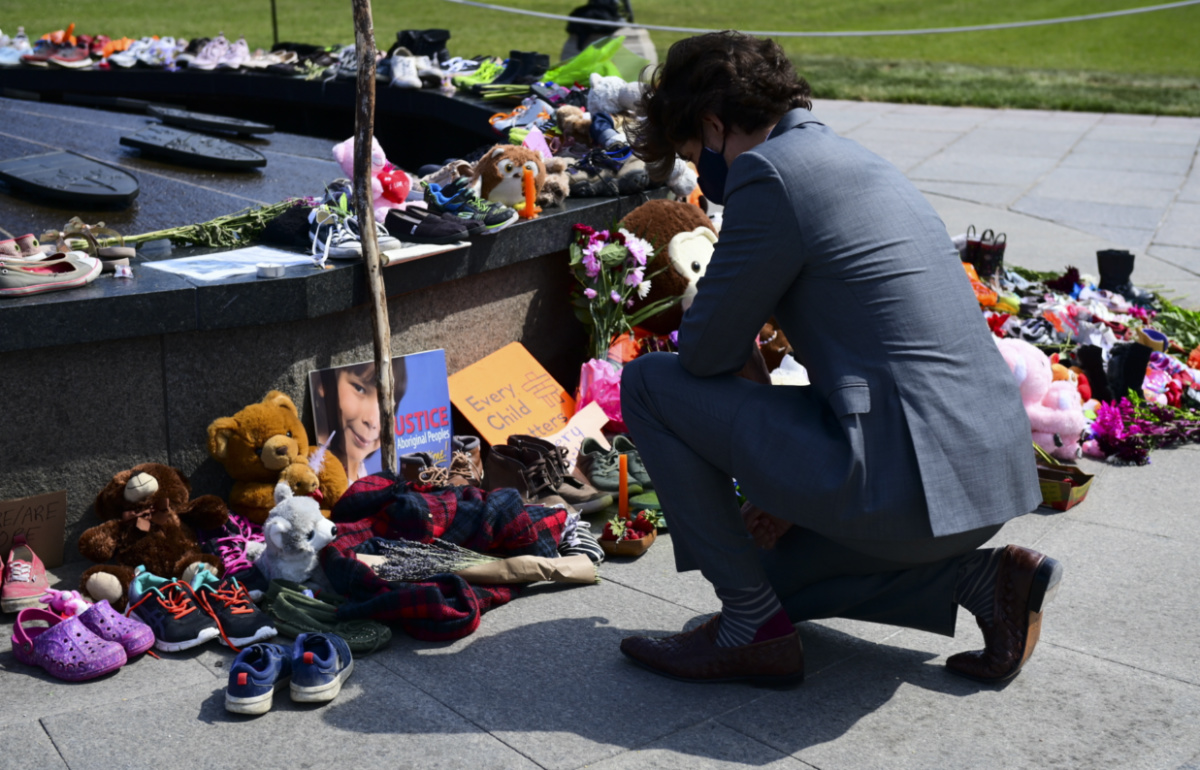A slew of church burnings across western Canada have left six churches on First Nations land badly damaged or destroyed as of Tuesday. Four of the churches are within an hour’s drive of one another in south-eastern British Columbia.
Sgt Jason Bayda of the Penticton South Okanagan Royal Canadian Mounted Police said in a statement that the police were “looking to determine any possible connection to the church fires.”

In this 1st June file photo, Canadian Prime Minister Justin Trudeau visits a memorial at the Eternal Flame on Parliament Hill in Ottawa that’s in recognition of discovery of children’s remains at the site of a former residential school in Kamloops, British Columbia. Leaders of Indigenous groups in Canada say investigators have found more than 600 unmarked graves at the site of a former residential school for Indigenous children in Saskatchewan. That follows last month’s discovery of about 215 bodies at another such school in British Columbia. PICTURE: Sean Kilpatrick/The Canadian Press via AP/File photo.
The burnings come at a time when Canada is reckoning with the recent discoveries of unmarked graves on the sites of former boarding schools for Indigenous children – many of which were run by churches. The remains of nearly 1,000 bodies have been found so far, most of them Indigenous children.
Chief Keith Crow of the Lower Similkameen Indian Band said his grandmother and her sisters were at one of the schools where remains were discovered.
“Everyone’s a descendant at some point,” he told Religion News Service.
But for Crow, the fires have only compounded the pain of residential school survivors who are hurting.
Crow arrived on the scene of one such fire Saturday morning. Community members across the street from Our Lady of Lourdes Church, on the Chopaka Native Reserve, spotted a vehicle outside, went out to to investigate and saw the fire start. Crow said he arrived at the church about 15 minutes later, before the Fire Department.
“If the community came to us and said we want to remove the churches, we would have done it – in a good way. But for one individual to go and do this without community consensus – it’s heartbreaking for the ones that utilise the church,” Crow said.
Where are the fires?
On 21st June, Sacred Heart Mission Church on Penticton Indian Band land in British Columbia and St Gregory Mission Church, 40 minutes to the south on Osoyoos Indian Band land, both burned down.
On 26th June, fire burned down St Ann’s Catholic Church in Hedley Native Reserve of the Upper Similkameen Indian Band and Our Lady of Lourdes Church, roughly 25 kilometres south.
On Saturday, a small fire also damaged St Paul’s Anglican Church on Gitwangak First Nations land in north-west British Columbia. The fire was put out before it could cause severe damage. Chief Sandra Larin acknowledged the pain caused by news of mass graves and encouraged the community to respect one another’s different beliefs.
“This is still a place of healing. The church still provides healing for those who choose to heal that way,” Larin said in a video statement.
On Monday, a Catholic church on Siksika First Nation land near Calgary also caught on fire briefly. The RCMP is investigating.
What are residential schools?
On 21st June, ground-penetrating radar revealed more than 750 unmarked graves on the grounds of Marieval Indian school, in Cowessess First Nation lands in Saskatchewan. The youngest remains in the graves appear to belong to children around three-years-old. This came just weeks after a team of scientists, in May, found 215 unmarked graves in a Kamloops Indian Residential School in Kamloops, British Columbia. Kamloops opened in 1890 and closed just 43 years ago.
Canada’s residential schools operated from 1883 to 1996. More than 150,000 First Nations children were required to attend boarding schools to separate them from their parents and families and eradicate their language and cultural heritage. In 2015, a Truth and Reconciliation Commission recorded nearly 1,500 hours of testimony from former inmates of the residential school program. The commission estimated about 6,000 of the 150,000 students died while in the schools.
The Catholic Church operated roughly 60 per cent of the schools. The discovery of unmarked graves has ramped up calls for the Catholic Church to take greater responsibility for its role in the “cultural genocide.”
Over the past week, protesters painted graffiti on Catholic churches in Saskatchewan and Alberta. Reuters reported on Friday that Prime Minister Justin Trudeau called on Pope Francis to apologise.
“I have spoken personally directly with His Holiness Pope Francis to press upon him how important it is not just that he makes an apology but that he makes an apology to Indigenous Canadians on Canadian soil.”
Crow said he hopes more schools in the area will search their grounds for graves and bring more of the history of residential schools – and the pain they have caused his community – to light.
“We are still here. The residential schools did not work. We still practice our culture. We still practice our language. And we’ll be here for many, many more millennia.”






